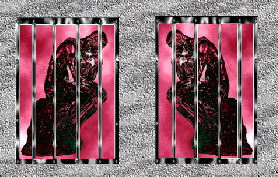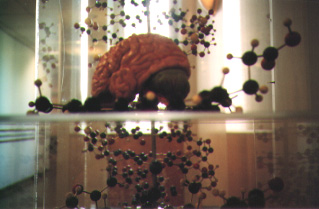PART 4:
GENES, ALTRUISM, AND EVOLUTION |
||||
Section 3: Game Theory and Evolution |
||||
| A lot of discussions of “human nature” and evolution often get down to a game theory called Prisoner’s Dilemma. It is actually a very useful tool for analyzing the type of altruistic behaviors we have been talking about thus far. I will briefly summarize the basic scenario and go into its evolutionary implications. | ||||
In the basic
scenario after which the game theory is named, two prisoners are known to have committed
crime X. However, the police want to convict
them of a more serious crime Y. The two prisoners are held in separate cells and are
offered a deal: |
||||
|
||||
| There are actually two choices here, to cooperate (remain silent in this scenario) or to betray. Cooperation technically means that you serve 1 or 3 years. In case of betrayal you may serve 0 or 2 years depending on the other prisoner’s choice. Since you don’t know how your partner will react (you are in different cells and can’t talk!), a reasonable thing to do according to Darwinian rules of survival is to do what gives you the most advantage (remember the survival of the fittest model). And that is to maximize the upside (zero years in prison) and minimize downside (get 2 instead of 3 years). | ||||
| When this game is played over and over in a programmed fashion, it turns out that the outcome is better for both players if they always cooperate than when they always defect. That is, in the first case, both will have a less total years in prison. | ||||
| Now if
you play the game so that you do on
this move what your partner did on the last move (called Tit a Tat strategy) the case is that
cooperation is rewarded and defection punished (if you betray me, I will betray you on the
next move!) The downside of this strategy is that you will never draw more points, i.e.
get less years in prison than your partner). However, if you cooperate on every move no
matter what your partner did you will inevitably suffer “the suckers payoff.”
Your partner will have no incentive to cooperate and you will be defeated almost
instantly. In such a game cooperation is the best strategy only if betrayal is punished. |
||||
| I used the example of Prisoner’s dilemma because it can be viewed as a set of defining set of circumstances under which people behave well towards others. What Prisoner’s Dilemma presents us with is the notion of “enlightened selfishness” both on the personal and evolutionary level. Prisoner’s Dilemma shows that in the personal sense, selfishness is enlightened…if I cooperate with you, you will likely cooperate with me (tit a tat strategy) and we will both score “in the game of life” sort of speak. If we keep betraying each other, we will both be losers at the end. Another aspect of behavior in the personal sense comes from what makes people “feel good” (I talked about this in the Last section but its worth mentioning to see how it ties into the rest of the story). Lets take the case of what people call “unconditional love” of a mother. Can we say it is selfish…how could it be? We often see mother’s sacrificing their well being to the betterment of their child. Evolutionary theory may be used to account for this phenomenon. The mother by sacrificing herself through whatever means, is helping her offspring who is younger and has better chances of producing more offsprings. However, we can’t trace back this behavior to evolution alone. That is, an important observation, which may be made, is that | ||||
|
||||
| The evolutionary process can generate behaviors, quos, etc, that can be experienced in the evolutionary process but whose meaning can be completely unhooked from its original biological motivation. Lets say that the evolutionary process produced a set of ques in females, say big breast, which at the time were a sign of a woman’s ability to produce more milk for her babies (more kids they can produce and feed, the more genes will propagate, so guys unconsciously will want to mate with these females!) Lets now imagine that these females became sterile and the obsession for big breast had nothing to do with its original motivation. | ||||
| Taking from such observations we can say that: | ||||
|
||||
| For instance, it is entirely possible that pleasurable sex originated because organisms that “felt good” having sex had more of it and thus passed on more genes. Human sex today serves entirely different role and in most cases is entirely unrelated to childbearing. To trace altruistic behaviors in humans to evolutionary history based entirely on Darwinian concepts of reproductive success does not grasp the phenomenon in its entirety. It is possible that throughout the course of evolution certain nervous systems bound tightly with others for reproductive success reasons. However, it should be kept in mind that altruism is a set of behavioral concepts that originated in the things we can study and use as objects of exploration. The Prisoner’s Dilemma does precisely this. But what it fails to explain in the evolutionary sense is the question of why there are so many instances in which we seemingly act in ways in which we are bound to get the “the sucker’s payoff. ” | ||||
| Altruism can likely be a rewarding
“feel good” behavior that has little to do with its original biological, perhaps
“selfish” intention. Certain behaviors which give a greater chance of
propagating our genes are likely to make us feel
good so that people who feel good about such
actions may have more offsprings. If a mother felt good about saving her kid, it is
possible her brain is organized in a way that she feels good saving another kid who is not
hers. We see heroic acts of a dozen of industrial workers who get overcome trying to
rescue another in fumes or jumping in to save another’s life. This can’t be
justified by cost-benefit analysis of Prisoner’s dilemma. The implications of this
are examined in the next section. |
||||
| LINKS ON GAME THEORY AND ALTRUISM | ||||
GAME THEORY The Prisoner’s Dilemma in Relationships ORIGINS OF VIRTUE PRISONER'S DILEMMA THE IDEA OF A SOCIAL CONTRACT GAME THEORY The Problem of Altruism |
||||

